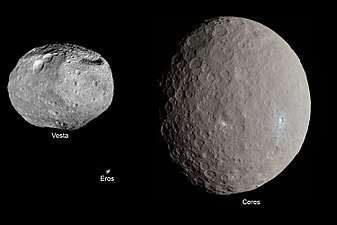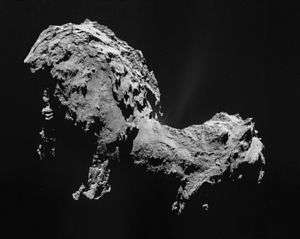List of missions to minor planets
List of missions to minor planets is a listing of spaceflight missions to minor planets, which are category of astronomical body that excludes planets, moons and comets, but orbit the Sun. Most missions to minor planets have been to asteroids or dwarf planets.
Spacecraft visits to minor planets have mostly been flybys, and have ranged from dedicated missions to incidental flybys and targets of opportunity for spacecraft that have already completed their missions. The first spacecraft to visit an asteroid was Galileo, which flew past 951 Gaspra in October 1991; an incidental encounter while the probe was en route to Jupiter. The first dedicated mission was NEAR Shoemaker, which was launched in February 1996, and entered orbit around 433 Eros in February 2000, having first flown past 253 Mathilde. NEAR was also the first spacecraft to land on an asteroid, surviving what was intended to be an impact with Eros at 20:01 on 12 February 2001 at the planned end of its mission. As a result of its unexpected survival, the spacecraft's mission was extended until 1 March to allow data to be collected from the surface.
Many minor planets are in two rings:
- Asteroid belt, between 2-3 AU
- Kuiper belt, between 30-60 AU
| Spacecraft | Launch date[1] | Targeted minor planet | Mission | Outcome | Remarks | Carrier rocket[2] |
|---|---|---|---|---|---|---|
| Galileo | 18 October 1989 | 951 Gaspra | Flyby | Successful | Incidental flyby en route to Jupiter; flyby occurred on 29 October 1991 with closest approach of 1,604 kilometres (997 mi) at 22:37 UTC[3] | Space Shuttle Atlantis STS-34 / IUS |
| 243 Ida | Flyby | Successful | Incidental flyby en route to Jupiter, discovered Dactyl; flyby occurred on 28 August 1993 with closest approach of 2,410 kilometres (1,500 mi) at 16:51:59 UTC[3] | |||
| Clementine (DSPSE) |
25 January 1994 | 1620 Geographos | Flyby | Spacecraft failure | Attitude control failure; failed to leave geocentric orbit after first phase of mission exploring the Moon. Flyby had been planned for August 1994[4] | Titan II(23)G |
| NEAR Shoemaker (Discovery 1) |
17 February 1996 | 253 Mathilde | Flyby | Successful | Closest approach 1,212 kilometres (753 mi) at 12:56 UTC on 27 June 1997[5] | Delta II 7925 |
| 433 Eros | Orbiter | Mostly successful | Aborted burn three days before arrival at Eros resulted in failure to enter orbit, instead flew past at 3,827 kilometres (2,378 mi) at 18:41:23 on 23 December 1998. Insertion reattempted successfully on 14 February 2000. Impacted asteroid at 20:01 on 12 February 2001 at end of mission, but survived impact and continued to operate on surface until 1 March.[5] | |||
| Cassini–Huygens | 15 October 1997[1] | 2685 Masursky | Flyby | N/A | Distant incidental flyby en route to Saturn; closest approach 1.5 million kilometres (0.9 million miles) at 09:58 UTC on 23 January 2000[6] | Titan IV(401)B Centaur-T[7] |
| Deep Space 1 | 24 October 1998 | 4015 Wilson–Harrington[8] | Flyby | Spacecraft failure | Spacecraft was unable to reach the asteroid due to ion engine operation being suspended while a problem with the probe's star tracker was investigated[9] | Delta II 7326 |
| 9969 Braille | Flyby | Partial failure | Closest approach 28.3 kilometres (17.6 mi) at 04:46 UTC[9] on 29 July 1999. Intended to pass within 14 kilometres (8.7 mi) but this was not achieved due to a computer failure; poor-quality images returned as a result.[10] Flyby added to mission following loss of ability to reach Wilson–Harrington | |||
| Stardust (Discovery 4) |
7 February 1999 | 5535 Annefrank[11] | Flyby | Successful | Closest approach of 3,079 kilometres (1,913 mi) at 04:50:20 UTC on 2 November 2002 | Delta II 7426 |
| Hayabusa (MUSES-C) |
9 May 2003 | 25143 Itokawa | Orbiter/lander Sample return |
Partial failure | Reached Itokawa on 12 September 2005, landed briefly on 19 and 25 November but sampler failed to operate, missed return window due to communications outage, finally returned to Earth on 13 June 2010 | M-V |
| MINERVA | 25143 Itokawa | Lander | Failure | Deployed from Hayabusa on 12 November 2005; Accidentally released while Hayabusa was moving away from Itokawa; reached escape velocity and drifted off into heliocentric orbit | ||
| Rosetta | 2 March 2004 | 2867 Šteins | Flyby | Successful | Closest approach 800 kilometres (500 mi) on 5 September 2008 | Ariane 5G+ |
| 21 Lutetia | Flyby | Successful | Closest approach 3,162 kilometres (1,965 mi) on 10 July 2010 | |||
| Deep Impact (Discovery 7) |
12 January 2005 | (163249) 2002 GT | Flyby | Spacecraft failure (Extended mission) |
Extended mission (EPOXI), flyby was expected in 2020, but communication with the spacecraft was lost in August 2013 | Delta II 7925 |
| New Horizons (New Frontiers 1) |
19 January 2006 | 132524 APL | Flyby | N/A | Incidental flyby en route to Pluto, closest approach 101,867 kilometres (63,297 mi) at 04:05 UTC on 13 June 2006 | Atlas V 551 |
| 134340 Pluto and its five moons. | Flyby | Successful | Flyby occurred on 14 July 2015 | |||
| 486958 Arrokoth | Flyby | Successful | Flyby occurred on 1 January 2019 | |||
| Dawn (Discovery 9) |
27 September 2007 | 4 Vesta | Orbiter | Successful | Orbited Vesta from 16 July 2011 to 5 September 2012, before departing for Ceres | Delta II 7925H |
| 1 Ceres | Orbiter | Successful | Arrived in 2015 | |||
| Chang'e-2 | 1 October 2010 | 4179 Toutatis | Flyby | Successful | Flyby on 13 December 2012, closest approach 3.2 kilometres (2.0 mi) | Chang Zheng 3C |
| Hayabusa2 | 3 December 2014 | 162173 Ryugu | Orbiter/lander Sample return |
Operational | Arrived in 2018, landed in February and July 2019 | H-IIA 202 |
| HIBOU | Lander | Operational | Deployed from Hayabusa2 on 21 September 2018 | |||
| OWL | Lander | Operational | Deployed from Hayabusa2 on 21 September 2018 | |||
| MINERVA II-2 | Lander | En route | To be deployed from Hayabusa2 during July 2019 | |||
| MASCOT | Lander | Successful | Deployed from Hayabusa2 on 3 October 2018; operated for 17 hours | |||
| SCI impactor | Impactor | En route | To be deployed from Hayabusa2 | |||
| DCAM-3 | Orbiter | En route | To be deployed from Hayabusa2, will be used to observe SCI impact | |||
| PROCYON | (185851) 2000 DP107 | Flyby | Spacecraft failure | Flyby had been planned for 2016; cancelled due to ion engine failure in heliocentric orbit[12] | ||
| OSIRIS-REx (New Frontiers 3) |
8 September 2016 | 101955 Bennu | Orbiter Sample return |
Operational | Orbiting 101955 Bennu since 31 December 2018 | Atlas V |
| Lucy (Discovery 13) |
2021 | 52246 Donaldjohanson | Flyby | Planned | 20 April 2025 | |
| 3548 Eurybates | Flyby | Planned | 12 August 2027 | |||
| 15094 Polymele | Flyby | Planned | 15 September 2027 | |||
| 11351 Leucus | Flyby | Planned | 18 April 2028 | |||
| 21900 Orus | Flyby | Planned | 11 November 2028 | |||
| 617 Patroclus | Flyby | Planned | 2 March 2033 | |||
| Psyche (Discovery 14) |
2022 | 16 Psyche | Orbiter | Planned | 2026 | Falcon 9[13] |
| ASTER [14][15] | 2021 | (153591) 2001 SN263 | Orbiter | Planned | Will orbit the triple system in 2022 | TBD |
References
- McDowell, Jonathan. "Launch Log". Jonathan's Space Page. Retrieved 21 April 2013.
- Krebs, Gunter. "Interplanetary Probes". Gunter's Space Page. Retrieved 21 April 2013.
- "Solar System Exploration - Galileo". NASA. Retrieved 21 April 2013.
- "Solar System Exploration - Clementine". NASA. Retrieved 21 April 2013.
- "Solar System Exploration - NEAR Shoemaker". NASA. Retrieved 21 April 2013.
- "Solar System Exploration - Cassini". NASA. Retrieved 21 April 2013.
- Krebs, Gunter. "Cassini". Gunter's Space Page. Retrieved 21 April 2013.
- Wilson–Harrington is catalogued as both a comet and an asteroid
- "Solar System Exploration - Deep Space 1". NASA. Retrieved 23 April 2013.
- Rayman, Marc D.; Varghese, Philip (2001). "The Deep Space 1 Extended Mission" (PDF). Acta Astronautica. 48 (5–12): 693–705. Bibcode:2001AcAau..48..693R. doi:10.1016/s0094-5765(01)00044-3.
- "STARDUST Successfully Images Asteroid Annefrank During Dress Rehearsal". NASA. 4 November 2002. Retrieved 23 April 2013.
- "Due to ion engine failure, PROCYON will not fly by an asteroid".
- http://www.lcpm10.caltech.edu/pdf/session-5/6_Elkins-Tanton%20Psyche%20LCPM-10%20FINAL.pdf
- Development of a Solar Electric Propulsion System for the First Brazilian Deep Space Mission. José Leonardo Ferreira, Alexandre A. Martins, Rodrigo Andres Miranda, Helbert O. C. Junior, Alvaro Q. D. R. Silva, and Ivan Soares Ferreira, Alexander Sukhanov, Othon Cabo Winter. Presented at the 35th International Electric Propulsion Conference. IEPC-2017-166. Georgia Institute of Technology - Atlanta, Georgia, USA. October 8-12, 2017.
- The ASTER Mission: Exploring for the First Time a Triple System Asteroid. (PDF) Elbert E.N. Macau, Othon Winter, Haroldo Fraga de Campos Velho. January 2011



